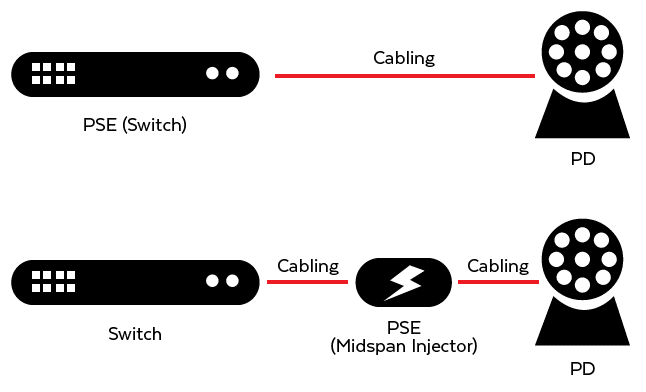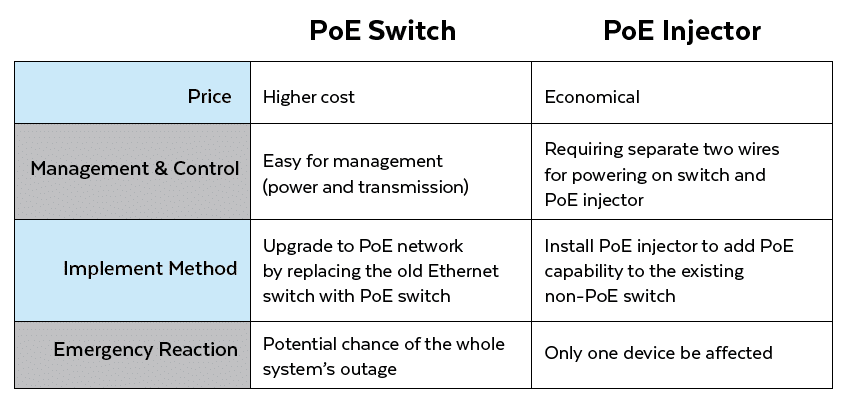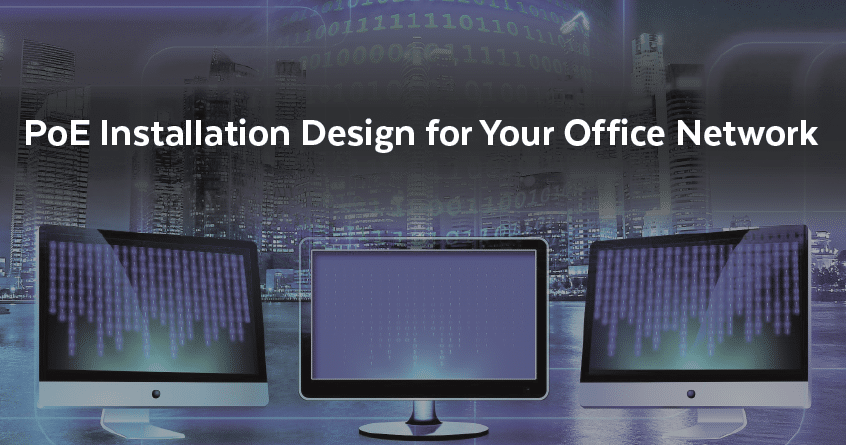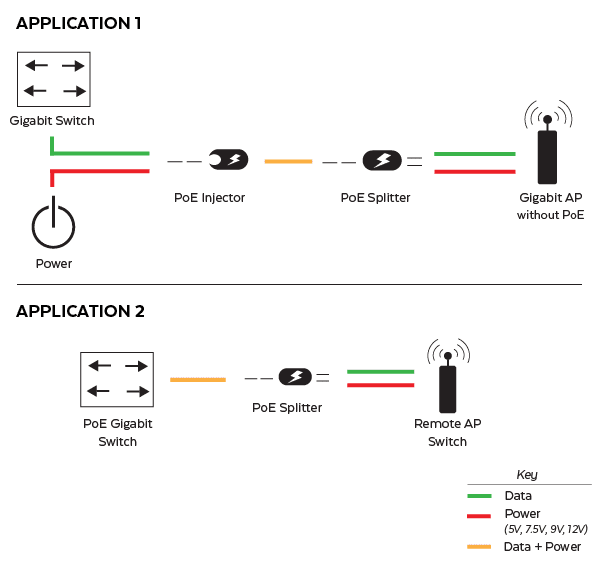There are many reasons to adopt Power over Ethernet (PoE) and implement a PoE installation for your office network. The most conspicuous of which are fewer cords at workstations and the ability to run these cords without the need for an electrician.
Traditionally, data centers have contained a bunch of electrical devices that each require a power supply cable and at least one connection wire for transmission. Unfortunately, that results in a lot of cables scattered all over the floor.
So, here is where PoE comes in!
PoE technology allows Ethernet cables to transmit both power and data simultaneously over a single line. This not only cuts the amount of wiring needed per device by half it also allows installers to deploy them in locations that lack electrical outlets.
So, how do you install PoE to your network?
There are two methods: adopting a PoE switch or a PoE injector.
The Basics of a PoE Circuit
A PoE circuit has three parts.
- Power Sourcing Equipment (PSE), which provides electrical power on the same cable as the data signals—usually in the form of a switch or injector
- Two-pair or four-pair twisted Ethernet cabling that meets the Institute of Electronic and Electrical Engineer (IEEE) standards for PoE
- Powered Device (PD), which consumes the power provided by the PSE
 This is how it works: The PD requests power, and the PSE supplies it. When the PD is disconnected, the PSE will remove all power. This system is considerably safer than traditional AC power, which is always present at the outlet. In addition, PoE uses lower voltages. (See the chart below.)
This is how it works: The PD requests power, and the PSE supplies it. When the PD is disconnected, the PSE will remove all power. This system is considerably safer than traditional AC power, which is always present at the outlet. In addition, PoE uses lower voltages. (See the chart below.)
The first generation of PoE was ratified by the IEEE in 2003. This PoE standard (IEEE 802.3af) is also called PoE or Type 1 and sources up to 15.4 watts (W) of power over two pairs of twisted copper wires. The second PoE standard (IEEE 802.3at) was ratified in 2005. It is referred to as PoE+ or Type 2 and sources up to 30 W over two twisted pairs. Finally, the latest PoE standard (IEEE 802.3bt) was adopted in 2018. This standard contains two power levels: PoE++ (Type 3) and Type 4, which sources up to 71.3 W and 100 W, respectively, using four twisted pairs.
An Overview of PoE Installation
First, PoE requires PoE-enabled PSE devices. There are two kinds:
- An endspan (or endpoint) device is an Ethernet switch with built-in PoE capabilities (called a PoE switch).
- A midspan device (called a PoE injector) is an intermediary PSE that lies between a non-PoE enabled switch and the PDs and injects PoE into the network).
PoE Installation via a PoE switch (Endspan)
When you want to upgrade your network or replace an old non-PoE switch, using an endspan is a good choice—and it is easy. All you have to do is connect the new PoE switch to the other devices (PDs) in your network (i.e., simple plug-and-play). From then on, the PoE switch will do all the work. For example, it will figure out if the PDs are PoE-supportive devices or not and will control the power automatically.
As a side note: There is a variety of PoE switches available that range from “dumb” unmanaged ones to smarter, partially managed ones to fully managed PoE switches with advanced capabilities. PoE switches also come with different port number selections, such as 8, 12, 24, and 48-port models. In addition, PoE switches come in industrially hardened casings that are suitable for harsh environments.
PoE Installation via a PoE Injector (Midspan)
Should you not want to discard a functioning network switch and only need to add PoE to your system, adopting midspan is your solution. A PoE injector adds electrical power by receiving a signal from a non-PoE switch, then delivers the data signal and power to the PD. As PoE injectors are less expensive than PoE switches, they can be an economical solution to adding PoE into a LAN if only a few PoE ports are needed.
The installation of a PoE injector is very straightforward. First, “power on” the PoE injector and the non-PoE Ethernet switch; next, connect both devices via a Cat5e, Cat6 or Cat6A Ethernet cable. The last step is to connect the PDs to the PoE injector, and the system is set to go.
Side note: If your network PDs are not PoE-ready, a PoE splitter can be the solution for adding PoE to your network. A splitter enables a non-PoE-compliant PD to upgrade to PoE. It has two outlet cables: one that supplies power and one that gives data.
PoE Switch or PoE Injector?
To help decide which PoE device is best for your situation, Sylvie Liu, Sr. Security Program Manager, ML Threat Detection for Microsoft, has developed a side-by-side comparison chart. (See chart below.)

Conclusion
Power over Ethernet is being adopted by both small and large enterprises at a steady rate. According to a recent report (Power over Ethernet Market forecast: 2021-2026), the PoE market was valued at $685.1 million in 2020 and is expected to grow at a CAGR of 12.6 percent during the forecast period of 2021-2026
While there are many reasons to adopt PoE into a workplace (e.g., lower costs and enhanced efficiency), perhaps the biggest benefit of all is flexibility. Creating a workspace that is safe, comfortable, and meets the needs of the workforce can only lead to increased productivity.
Furthermore, the adoption of PoE will help future proof your business. The Internet of Things (IoT) is continually getting more intricate and complex, providing more and more smart, data-hungry devices each day. It is impractical (and maybe even impossible) to connect everything to AC. Upgrading to PoE allows a single cable to provide both power and data transmission, thus positioning an enterprise to be ready for the coming changes.
Versa Technology is proud of its 25+ years as a purveyor of market industry-leading products that are versatile, user-friendly, and cost-effective. Our equipment is ideal for developed or developing enterprises, large or small. Our goal to provide the best of customer service is unwavering.


